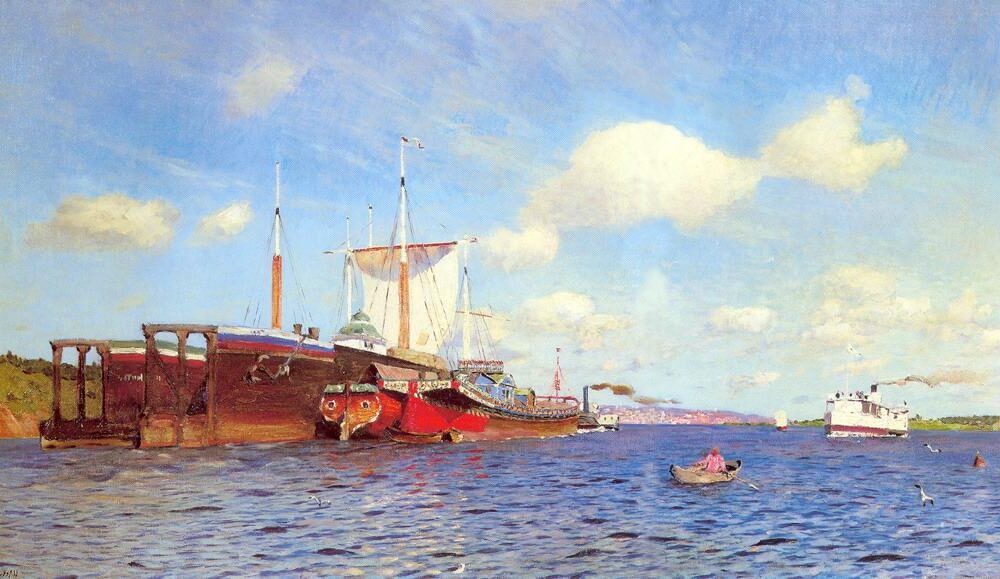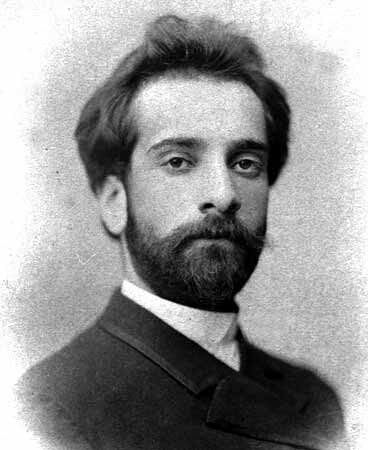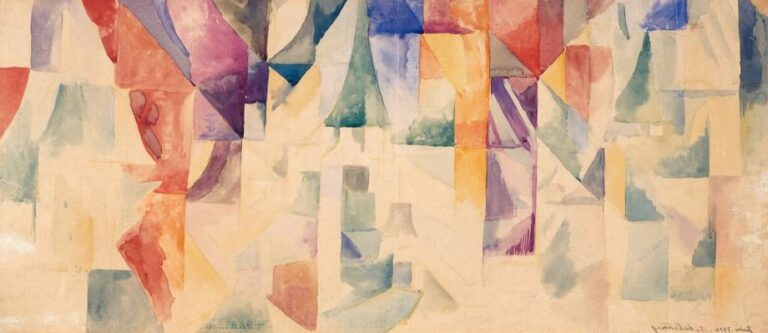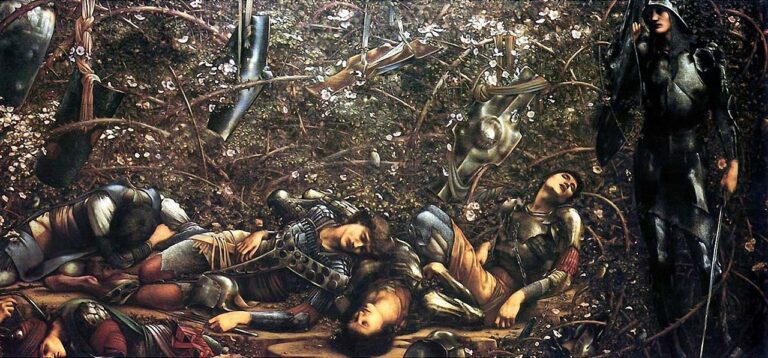Isaac Levitan Painter: Master of Russian Landscape Art
Born: 30 August [O.S. 18 August] 1860
Kibarty, Augustów Governorate, Congress Poland, Russian Empire
Death: 4 August [O.S. 22 July] 1900, Moscow, Russian Empire
Art Movement: Realism, Peredvizhniki, Impressionism
Nationalité : Russe
Teachers: Alexei Savrasov, Vasily Perov, and Vasily Polenov
Institution : École de peinture, de sculpture et d'architecture de Moscou
Isaac Levitan Painter: Master of Russian Landscape Art
Biography of Isaac Levitan
Isaac Ilyich Levitan was a remarkable Russian landscape painter who transformed the genre with his emotive “mood landscapes.” His short but impactful life took him from humble beginnings to becoming one of Russia’s most influential artists.
Vie et éducation précoces
Born on August 18, 1860, in Kibarty (now Kibartai, Lithuania) in the Russian Empire, Levitan came from a modest Jewish family. His father, Ilya Abramovich Levitan, worked as a railroad employee. The family faced financial hardships and eventually moved to Moscow in search of better opportunities.
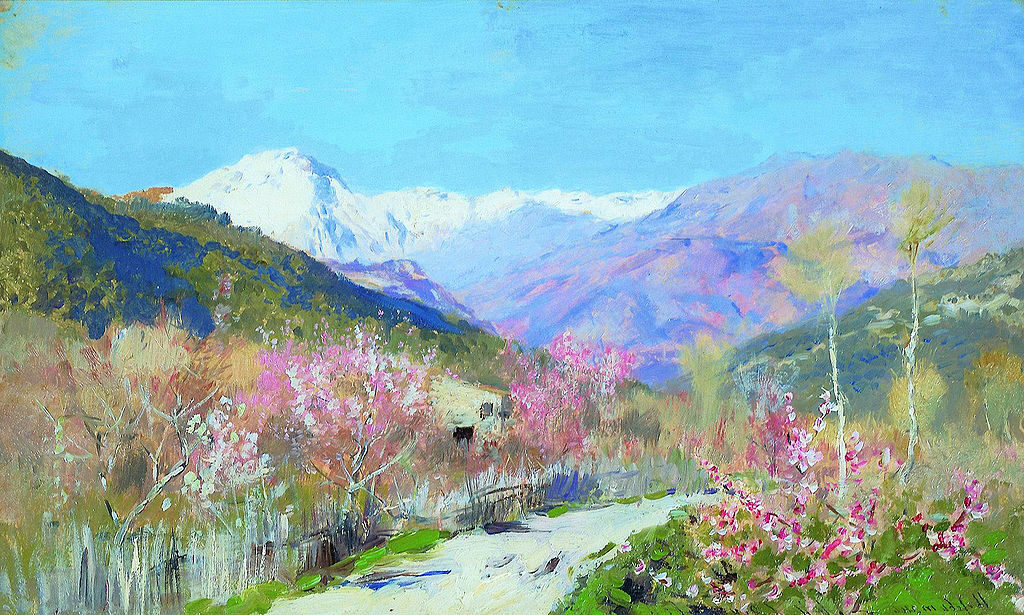
Spring in Italy, 1890, by Isaac Levitan
At age 13, Levitan enrolled in the Moscow School of Painting, Sculpture and Architecture. Despite his talent, he struggled with poverty after his parents died. The school sometimes waived his tuition fees because they recognized his extraordinary artistic abilities.
During these formative years, Levitan studied under significant Russian painters including Vasily Perov and Alexei Savrasov, who recognized his exceptional talent for landscape painting.
Développement artistique et influences
Levitan’s artistic style evolved from traditional realism toward a more emotionally expressive approach to landscape painting. Vasily Polenov’s influence helped shape Levitan’s technique and color sensibility during his studies.
His Jewish origins occasionally created obstacles in Tsarist Russia, and in 1879 he was temporarily forced to leave Moscow during an expulsion of Jews from the city. These experiences and hardships likely contributed to the melancholic mood often present in his paintings.
The Russian countryside became Levitan’s primary subject and inspiration. He traveled extensively, capturing diverse landscapes from the Volga River to the Crimean coast. His friendship with writer Anton Chekhov proved significant for both artists, with each influencing the other’s work.
Les dernières années et l'héritage
In the 1890s, Levitan achieved significant recognition. He was named a member of the prestigious Itinerants group and later became a full member of the Imperial Academy of Arts, despite ongoing anti-Semitism in Russian society.
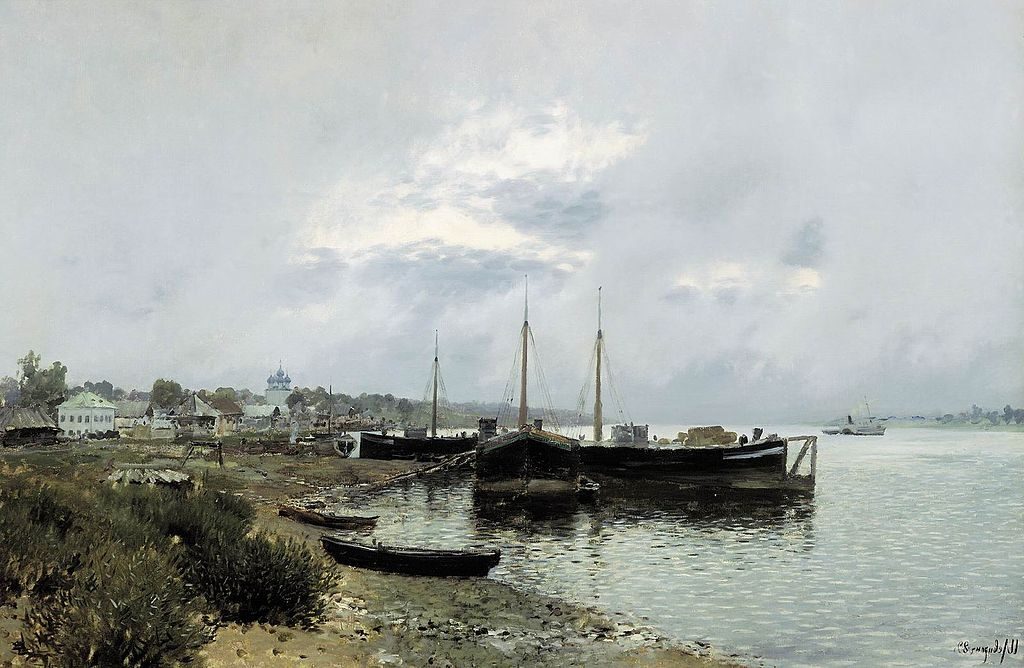
Plyos, 1889, by Isaac Levitan
Levitan’s health deteriorated in his final years due to heart problems. He continued painting despite his illness, creating some of his most powerful works during this period. He died on July 22, 1900, at just 39 years old.
Originally buried at Dorogomilovo Jewish Cemetery, his remains were later transferred to Novodevichy Cemetery in Moscow. Though his life was brief, Levitan left an extraordinary artistic legacy of approximately 1,000 paintings and drawings that profoundly influenced Russian art.
Levitan’s Contribution to Art
Isaac Levitan transformed Russian landscape painting through his deep emotional connection to nature and masterful technique. His innovative approach influenced generations of artists and helped establish landscape art as a meaningful expression of Russian identity.
Innovation in Landscape Painting
Levitan brought a unique perspective to landscape painting by infusing his works with mood and emotion. Unlike many contemporaries, he avoided urban scenes, focusing entirely on rural Russian landscapes that captured the soul of his homeland.
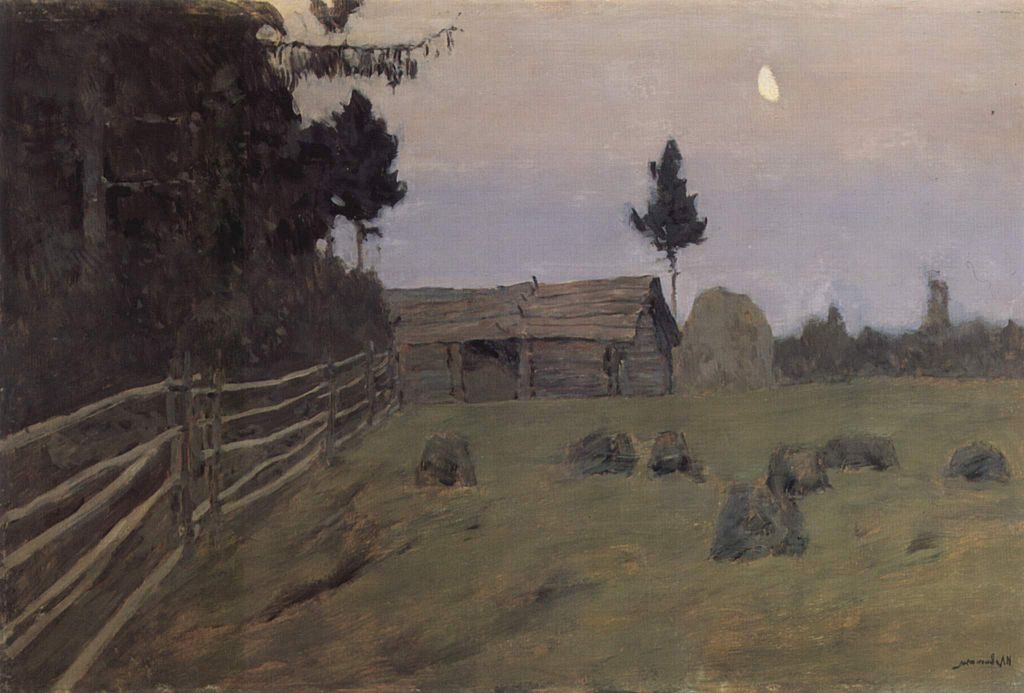
Dusk, 1900, by Isaac Levitan
His greatest innovation was the “mood landscape” – scenes that conveyed specific emotional states through subtle use of light, color, and composition. Levitan’s naturalistic approach combined with poetic sensibility created works that spoke to viewers on a deeper level.
Though influenced by Impressionism, Levitan developed his own distinct style. He captured fleeting moments of tranquility and melancholy in pastoral landscapes with remarkable sensitivity. His masterful technique showed in his ability to render light filtering through trees or reflecting on water.
Levitan worked in various media, including pastels and graphics, but his oil paintings remain his most celebrated achievements. His illustrations also demonstrated his versatility as an artist.
Associations with Peredvizhniki and Other Artists
Levitan maintained strong connections with the Peredvizhniki (Wanderers), a progressive group of Russian realist artists. Though his style evolved beyond strict realism, he shared their commitment to depicting authentic Russian scenes.
His mentor Alexei Savrasov greatly influenced his early development. Even after Savrasov was dismissed from the Art School, Levitan remained loyal and continued seeking his guidance.
Savva Mamontov, the wealthy industrialist and arts patron, supported Levitan’s career. Levitan contributed to Mamontov’s Private Russian Opera projects, demonstrating his connection to broader artistic circles.
Levitan’s relationships with other artists fostered a creative environment that helped elevate landscape painting in Russia. His work inspired contemporaries to develop a deeper feeling for nature in their own art.
Public Exhibitions and Collections
Levitan’s works were publicly exhibited during his lifetime, bringing his vision of Russian landscape to wide audiences. His paintings received critical acclaim at exhibitions organized by the Peredvizhniki.

Savvinskaya Sloboda near Zvenigorod, 1884, by Isaac Levitan
Pavel Mikhailovich Tretyakov, the famous art collector, recognized Levitan’s talent early and acquired several of his paintings for his gallery. Today, the Tretyakov Gallery houses a significant collection of Levitan’s works.
Museums throughout Russia and beyond now feature Levitan’s paintings as essential examples of Russian landscape art. His works are considered national treasures that capture the essence of Russian natural beauty.
Levitan’s paintings continue to inspire both artists and viewers over a century after his death. The accessibility and emotional resonance of his landscapes ensure his lasting contribution to art history.
Œuvres notables et style artistique
Isaac Levitan transformed Russian landscape painting with his distinctive approach that combined technical mastery with deep emotional resonance. His works captured the essence of Russian countryside while conveying complex moods through careful attention to light, color, and composition.
Depiction of Russian Nature
Levitan’s paintings celebrated Russian landscapes with remarkable authenticity and depth. Works like “The Vladimirka Road” (1892) and “Eternal Rest” (1894) showcase his ability to find profound meaning in ordinary rural scenes. Unlike many contemporaries, Levitan avoided romanticizing nature, instead presenting it honestly while still revealing its inherent beauty.
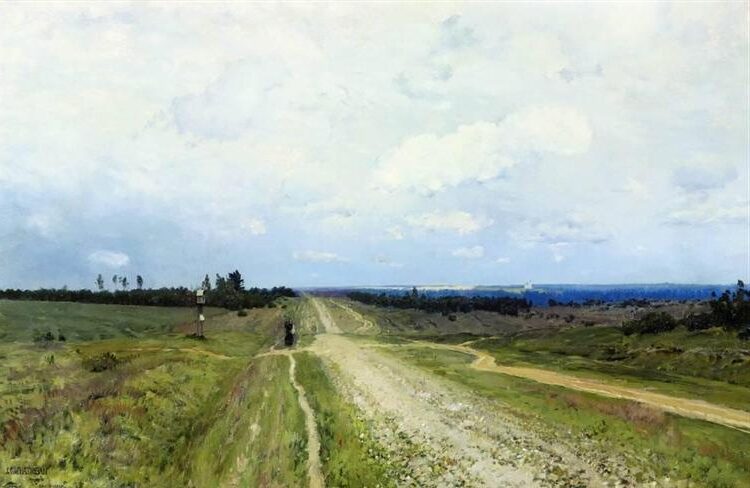
The Vladimir’s Road, 1892, by Isaac Levitan
His painting “Autumn Day. Sokolniki” marked an early achievement that demonstrated his talent for capturing seasonal nuances. This work caught the attention of notable collector Pavel Tretyakov.
Levitan learned from his teacher Alexei Savrasov to seek the subtle poetry in Russian landscapes rather than pursuing more dramatic vistas. This approach became central to his artistic identity.
Utilisation de la lumière et de la couleur
Levitan masterfully employed light and color to create atmospheric effects and emotional depth. His technique evolved from darker palettes toward brighter tones influenced by French Impressionists, though he maintained his distinctive style.
In “Spring” and “Moonlit Night,” Levitan demonstrates remarkable skill in capturing ephemeral lighting conditions. His paintings often feature carefully balanced color harmonies that evoke specific times of day or weather conditions.
Unlike Monet and other Impressionists, Levitan’s work retained more structure while still celebrating the changing effects of light. He particularly excelled at depicting the golden hours of dawn and dusk across Russia’s vast landscapes.
His urban scenes like “View of Simonov Monastery” and “Illumination of the Kremlin” reveal his versatility in handling artificial light alongside natural illumination.
Themes of Melancholy and Reverie
Levitan pioneered what critics called the “landscape of mood” in Russian art. His works often carry a sense of melancholic reverie that reflects both personal struggles and broader Russian cultural sentiments.
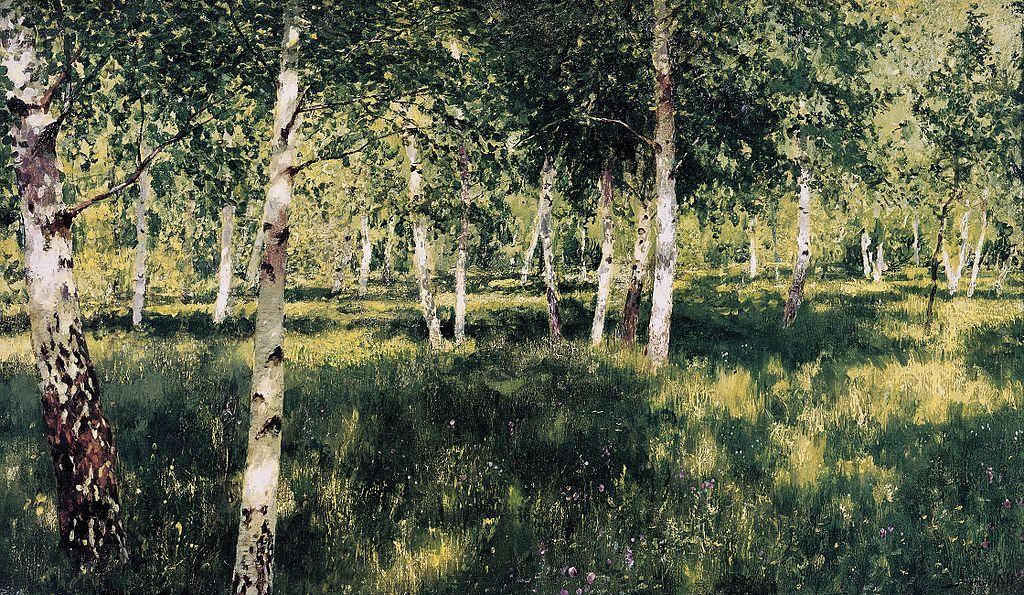
Birch Forest, 1885–1889, by Isaac Levitan
“Evening Bells” (1892) exemplifies this approach, evoking spiritual contemplation through its serene river scene. Many paintings contain a quiet tension between beauty and sadness that resonates with viewers on an emotional level.
Levitan’s friendship with writer Anton Chekhov influenced this psychological dimension in his work. Both artists excelled at finding profound meaning in seemingly ordinary moments.
The pastoral landscapes from his visits to the Augustów Governorate reveal how Levitan found both solace and creative inspiration in nature despite his often troubled personal life.
Questions fréquemment posées
Isaac Levitan’s legacy prompts many questions about his work and impact on Russian art. Below are answers to common inquiries about this influential landscape painter who captured the essence of Russian wilderness with remarkable sensitivity.
What are the notable works of Isaac Levitan?
Levitan created several masterpieces that showcase his exceptional talent for landscape painting. “The Vladimirka Road” (1892) depicts a path used by prisoners being sent to Siberia, combining natural beauty with historical significance.
“Golden Autumn” (1895) captures the vibrant colors of fall in the Russian countryside. This painting demonstrates Levitan’s ability to convey seasonal changes through color and light.
“Above Eternal Rest” (1894) shows a small church overlooking a lake, creating a powerful meditation on mortality and peace. His “March” (1895) brilliantly depicts the transitional period between winter and spring.
What were the primary themes in Isaac Levitan’s paintings?
The Russian countryside dominated Levitan’s work, revealing his deep connection to his homeland’s natural beauty. He focused particularly on capturing mood and atmosphere rather than just physical landscapes.
Levitan often explored melancholy, solitude, and the passing of time in his paintings. His works frequently feature transitional seasons and times of day, reflecting his interest in moments of change.
The relationship between humans and nature appears as a subtle theme throughout his portfolio. Unlike some contemporaries, he rarely included people as central figures, instead letting the landscape itself convey human emotions.
Which museums feature collections of Isaac Levitan’s art?
The Tretyakov Gallery in Moscow houses the largest collection of Levitan’s works. This prestigious institution contains many of his most famous paintings, making it essential for those studying his contributions.
The Russian Museum in St. Petersburg also displays significant Levitan pieces. Several regional Russian museums feature his paintings, particularly those in areas where he traveled and worked.
Some international collections, including the National Gallery in London, occasionally display his works. However, the most comprehensive collections remain in Russia, where his artistic legacy is most celebrated.
Can you describe the influence of Russian landscapes on Isaac Levitan’s work?
The diverse Russian wilderness provided endless inspiration for Levitan’s artistic vision. He traveled extensively throughout Russia, capturing the unique qualities of different regions in his paintings.
Levitan was particularly drawn to the modest beauty of central Russia, with its rivers, forests, and meadows. Unlike some artists who sought dramatic vistas, he found profound meaning in ordinary scenes of the Russian countryside.
The changing seasons of Russia, from snowy winters to golden autumns, gave Levitan a rich visual vocabulary. His intimate knowledge of these landscapes allowed him to capture subtle atmospheric conditions with remarkable accuracy.
What techniques and styles did Isaac Levitan employ in his paintings?
Levitan mastered the ability to capture light and atmosphere through careful observation. He often used a limited color palette but created depth through subtle variations in tone and texture.
His brushwork evolved throughout his career, becoming looser and more expressive in his later works. While rooted in realism, his style incorporated elements of impressionism, particularly in his treatment of light.
Levitan frequently painted en plein air (outdoors) to capture immediate impressions of nature. His composition typically emphasized horizontal lines and open spaces, creating a sense of vastness in the Russian landscape.
How has Isaac Levitan contributed to Russian art history?
Levitan elevated landscape painting to new heights in Russian art. He moved beyond mere documentation to emotional expression. He is considered one of the most influential figures in developing what became known as the “mood landscape.”
As a key member of the Peredvizhniki (The Wanderers) movement, Levitan helped shape Russian national artistic identity. His work bridged traditional Russian art with modernist sensibilities emerging in Europe.
Levitan’s influence extended through his teaching and relationships with other artists. His loyal relationship with his teacher Alexei Savrasov demonstrates the continuity of artistic traditions. This happened even as he developed his unique voice.

